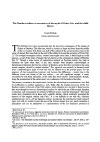Khoiak mysteries
« The Dendera zodiacs as narratives of the myth of Osiris, Isis, and the child Horus »
ENiM 8, 2015, p. 133-185.
 À part les signes clairement identifiables de la bande zodiacale, des quatre constellations conventionnelles égyptiennes et des planètes, les autres dessins des deux zodiaques de Dendera semblent dériver des systèmes de représentation traditionnels égyptiens. Ces représentations avec les figures des décans enregistrent des phénomènes célestes et des événements de culte référant qui racontent l’histoire de la mort et la résurrection d’Osiris, la fécondation d’Isis par son mari décédé et la naissance de leur enfant Horus. Ici les aspects astraux des mythes s’attachent aux phases de la lune, au cycle annuel du soleil et au lever héliaque de Sirius. Ainsi, les zodiaques, ne sont-ils pas des catalogues de constellations, mais des cartes du ciel conçus à un moment donné qui correspond à la coïncidence de la pleine lune et de l’équinoxe d’automne en 52 av. J.-C. et en 36 apr. J.-C.
À part les signes clairement identifiables de la bande zodiacale, des quatre constellations conventionnelles égyptiennes et des planètes, les autres dessins des deux zodiaques de Dendera semblent dériver des systèmes de représentation traditionnels égyptiens. Ces représentations avec les figures des décans enregistrent des phénomènes célestes et des événements de culte référant qui racontent l’histoire de la mort et la résurrection d’Osiris, la fécondation d’Isis par son mari décédé et la naissance de leur enfant Horus. Ici les aspects astraux des mythes s’attachent aux phases de la lune, au cycle annuel du soleil et au lever héliaque de Sirius. Ainsi, les zodiaques, ne sont-ils pas des catalogues de constellations, mais des cartes du ciel conçus à un moment donné qui correspond à la coïncidence de la pleine lune et de l’équinoxe d’automne en 52 av. J.-C. et en 36 apr. J.-C.
 Besides the unambiguously identifiable depictions of the zodiacal belt, four conventional Egyptian asterisms, and the planets, the other signs that feature in the two Dendera zodiacs are shown to derive from traditional Egyptian representational systems. These images, together with the accompanying figures of the decans, are incorporated into the design of the monuments to record celestial events and related cultic acts that tell the story of Osiris’s death and resurrection, the conception of Isis from her deceased husband, and the nativity of their child, Horus. The astral aspects of these myths are connected with the phases of the moon, the yearly solar cycle, and the annual dawn rising of the star Sirius. The zodiacs are thus not catalogues of constellations but peculiar sky charts devised at specific moments of time that correspond to the coincidence of the full moon with the autumnal equinox in the years 52 BCE and 36 CE.
Besides the unambiguously identifiable depictions of the zodiacal belt, four conventional Egyptian asterisms, and the planets, the other signs that feature in the two Dendera zodiacs are shown to derive from traditional Egyptian representational systems. These images, together with the accompanying figures of the decans, are incorporated into the design of the monuments to record celestial events and related cultic acts that tell the story of Osiris’s death and resurrection, the conception of Isis from her deceased husband, and the nativity of their child, Horus. The astral aspects of these myths are connected with the phases of the moon, the yearly solar cycle, and the annual dawn rising of the star Sirius. The zodiacs are thus not catalogues of constellations but peculiar sky charts devised at specific moments of time that correspond to the coincidence of the full moon with the autumnal equinox in the years 52 BCE and 36 CE.
 Consulter cet article (68087) -
Consulter cet article (68087) -  Télécharger cet article au format pdf (27259)
Télécharger cet article au format pdf (27259)
ENiM 18 - 2025
8 article(s) - 8 octobre 2025.
ENiM 1 à 18 (2008-2025) : 227 articles
5 176 714 téléchargements
10 341 759 consulations.
Index des auteurs

Mots clés

Derniers articles : 
CENiM - Mise en ligne des volumes Ă©puisĂ©s : 
 Anne-Sophie von BOMHARD DĂ©cans Ă©gyptiens, CENiM 23, Montpellier, 2020 — (2020)
Anne-Sophie von BOMHARD DĂ©cans Ă©gyptiens, CENiM 23, Montpellier, 2020 — (2020) 
 Jean-Claude Grenier L'Osiris ANTINOOS, CENiM 1, Montpellier, 2008 — (26 dĂ©cembre 2008)
Jean-Claude Grenier L'Osiris ANTINOOS, CENiM 1, Montpellier, 2008 — (26 dĂ©cembre 2008) 
TDENiM - Mise en ligne des volumes Ă©puisĂ©s : 
 Twitter
Twitter 4139299 visites - 7624 visite(s) aujourd’hui - 200 connecté(s)
© ENiM - Une revue d’égyptologie sur internet
Équipe Égypte Nilotique et Méditerranéenne - UMR 5140 - « Archéologie des Sociétés Méditerranéennes » (Cnrs) - Université Paul Valéry - Montpellier III






















 Contact
Contact
 Abonnez-vous !
Abonnez-vous ! Équipe Égypte Nilotique et Méditerranéenne
Équipe Égypte Nilotique et Méditerranéenne UMR 5140 « Archéologie des Sociétés Méditerranéennes » (Cnrs)
UMR 5140 « Archéologie des Sociétés Méditerranéennes » (Cnrs) Université Paul Valéry - Montpellier III
Université Paul Valéry - Montpellier III